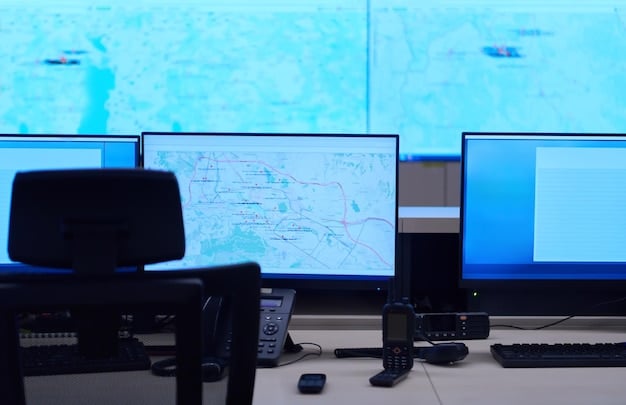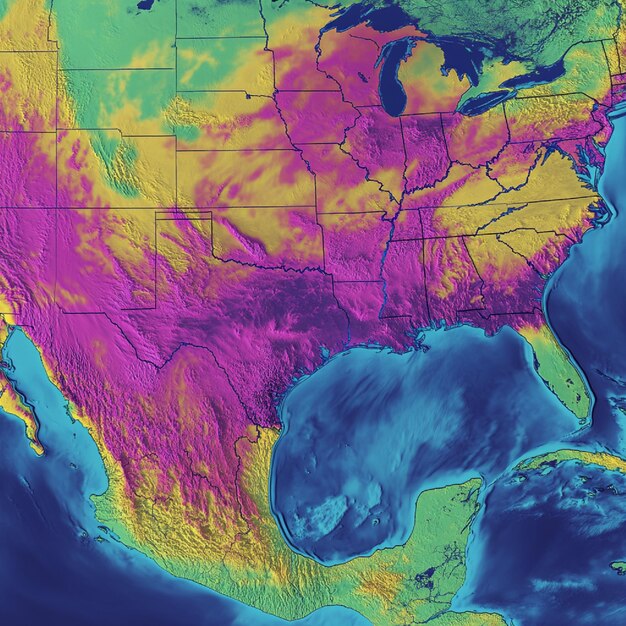NOAA’s 2025 Alert System: Your Guide to Updated Extreme Weather Warnings

The updated NOAA Extreme Weather Alert System for 2025 integrates advanced forecasting and localized data to provide more precise and timely warnings, enhancing public safety and preparedness for severe meteorological events across the United States.
As our climate evolves, so too must our defense mechanisms against its most volatile expressions. For those seeking a comprehensive resource on climate preparedness, Understanding the Updated NOAA Extreme Weather Alert System: A 2025 Guide offers an indispensable overview. This system represents a critical leap forward in how the United States prepares for and responds to severe weather, reflecting years of scientific advancement and operational refinement. Staying informed about these changes is not merely advisable; it is essential for personal and community safety in an era of unpredictable weather patterns.
The Evolving Landscape of Extreme Weather
The frequency and intensity of extreme weather events have undeniably shifted over recent decades, urging a reevaluation of our warning systems. From unprecedented heatwaves to more destructive hurricanes and extensive drought periods, the meteorological tapestry of the United States is continuously being redrawn. This necessitates a dynamic and responsive alert infrastructure, one that can adapt to new challenges while leveraging the latest technological breakthroughs in atmospheric science.
Historically, weather warnings relied on less sophisticated models and observational data, leading to broader, less localized alerts. While effective at a basic level, these often resulted in “warning fatigue,” where frequent, generalized alerts desensitized the public. The push for more precise forecasting and tailored warnings has been a long-standing goal within the meteorological community, driven by the understanding that accuracy directly correlates with public engagement and response efficiency. The 2025 updates to the NOAA system are a direct response to these evolving needs, aiming to bridge the gap between scientific capability and practical application for everyday citizens.
The Urgency for Enhanced Preparedness
Communities across the US face varying, yet increasingly significant, risks from extreme weather. Coastal regions grapple with rising sea levels and intensified storm surges, while the interior contends with severe droughts, wildfires, and violent tornado outbreaks. The economic and human costs associated with these events underscore the critical need for superior alert mechanisms. Preparedness is no longer a reactive measure but a proactive strategy, and a robust alert system forms its cornerstone.
- Economic Impact: Billions of dollars in damages annually from extreme weather events, affecting infrastructure, agriculture, and local economies.
- Human Toll: Loss of life, injuries, and long-term health consequences for affected populations, highlighting the need for efficient evacuation and safety protocols.
- Societal Disruption: Displacement of communities, interruption of essential services, and strain on emergency response resources.
Understanding these impacts provides the context for NOAA’s ongoing commitment to refining its alert system. Each update is designed to mitigate these consequences, offering clearer, more actionable information that empowers individuals and communities to make informed decisions when seconds count. The transition towards more granular, data-driven alerts is a testament to this commitment, aiming to maximize public safety and minimize damage.
The changes in the NOAA extreme weather alert system reflect not only technological advancements but also a deeper understanding of human behavior in response to warnings. By studying how people receive, interpret, and act upon alerts, meteorologists and social scientists collaborate to design systems that are not just technically sound but also psychologically effective. This holistic approach ensures that the alerts issued are not just accurate from a scientific standpoint, but also resonate with the public, fostering trust and encouraging timely action.
Ultimately, the continuous evolution of our warning systems is a shared responsibility. While NOAA provides the tools and information, it is up to individuals and communities to understand and utilize them effectively. The emphasis on education and public awareness remains paramount, ensuring that the enhanced capabilities of the 2025 system translate into tangible safety benefits for all.
Key Advancements in the 2025 NOAA System
The 2025 update to the NOAA Extreme Weather Alert System is not merely an incremental change; it represents a significant technological and operational leap. Central to these advancements is the integration of cutting-edge data analytics, artificial intelligence, and improved communication protocols. These elements work in concert to deliver warnings that are more precise, timely, and actionable than ever before, moving beyond broad regional alerts to highly localized notifications.
One of the most impactful changes is the enhanced spatial resolution of weather models. Where previous systems might have projected warnings over an entire county, the 2025 iteration can pinpoint threats down to specific neighborhoods or even individual blocks. This hyper-localization reduces instances of “false alarms” for areas not directly threatened, thereby increasing the credibility of warnings for those truly at risk. It also allows emergency responders to allocate resources more efficiently, focusing on the areas most likely to be impacted.
Advanced Predictive Modeling and AI Integration
At the heart of the 2025 system lies a new generation of predictive models, significantly bolstered by machine learning and artificial intelligence. These AI algorithms are capable of processing vast amounts of meteorological data – from satellite imagery and radar scans to atmospheric soundings and ground observations – at unprecedented speeds. This allows for the identification of subtle atmospheric patterns that might otherwise go unnoticed, providing earlier indications of severe weather development.
- Machine Learning for Pattern Recognition: AI identifies nascent severe weather signatures with greater accuracy, leading to earlier warnings.
- Ensemble Forecasting Refinement: Integration of multiple model outputs to provide a more robust probabilistic forecast, reducing uncertainty.
- Real-time Data Assimilation: Continuous ingestion of new data into models, allowing for rapid adjustments to forecasts as conditions evolve.
The integration of AI also extends to post-analysis, where the system learns from past forecast successes and failures. This continuous learning loop refines the algorithms over time, leading to increasingly accurate predictions. It’s a proactive approach to forecasting, moving from merely predicting what will happen to understanding why and how it will happen with greater certainty.
Moreover, the system incorporates advanced telecommunication infrastructure, ensuring that these hyper-localized alerts reach the intended recipients through multiple channels. This multi-channel approach is crucial for redundancy and accessibility, recognizing that different individuals rely on different forms of communication during emergencies.
The emphasis on predictive accuracy and rapid dissemination marks a new era in weather preparedness. Instead of simply reacting to unfolding events, the 2025 system aims to provide communities with the lead time necessary to prepare adequately, whether that means securing property, seeking shelter, or evacuating. This proactive capability is what truly distinguishes the updated NOAA system.

Understanding the New Alert Tiers and Terminology
With the updated NOAA system comes a refined set of alert tiers and standardized terminology, designed to minimize confusion and enhance clarity for the public. The goal is to provide a logical progression of alerts, clearly distinguishing between potential threats and imminent dangers. This structured approach helps individuals and communities assess risk levels more accurately and respond appropriately, preventing both complacency and unnecessary panic.
Previously, distinctions between watch and warning categories could sometimes be ambiguous, leading to varied interpretations. The 2025 framework introduces more granular levels, each with distinct action-oriented implications. For instance, new sub-categories within existing warnings might specify the exact nature and intensity of the threat, such as “Thunderstorm Warning: Large Hail & Damaging Winds” versus “Thunderstorm Warning: Flash Flood Risk.”
Refined Watch vs. Warning Definitions
The fundamental distinction between a “Watch” and a “Warning” remains, but with sharpened definitions and clearer communication around each. A “Watch” continues to signify that conditions are favorable for a particular severe weather event to occur within a specified area and timeframe. It’s a call for increased awareness and preparedness, a signal to monitor conditions and review safety plans.
- Watch: “Conditions are favorable for severe weather development.”
Action: Be aware, monitor updates, have a plan ready. - Warning: “Severe weather is occurring or is imminent.”
Action: Take immediate protective action.
The significant enhancement lies in the specificity accompanying these terms. For example, a “Tornado Watch” in the 2025 system might be followed by geo-targeted alerts indicating specific corridors of higher probability within the watch area. Similarly, “Warnings” will provide more precise details about the expected impacts, such as specific wind speeds, hail sizes, or rainfall rates, rather than general hazard statements.
New terminology will also be introduced to address emerging threats or to provide more granular detail on existing ones. For instance, specific advisories might be issued for “Extreme Heat Risks” that factor in local heat island effects, or “Wildfire Smoke Advisories” that incorporate real-time air quality data for precise health recommendations. This level of detail empowers individuals to make highly informed decisions based on their immediate circumstances.
The new terminology aims for universal understanding, regardless of technical background. NOAA has conducted extensive public outreach and usability testing to ensure that the updated language is intuitive and unambiguous across diverse demographics. This commitment to clear communication is as vital as the scientific advancements themselves, ensuring that the critical information reaches and resonates with everyone.
It’s important for the public to familiarize themselves with these refined terms and their associated actions. Public awareness campaigns and educational materials will be widely distributed leading up to and throughout 2025, emphasizing the practical implications of each alert level. This proactive education is crucial to maximizing the effectiveness of the enhanced system and ensuring a more resilient nation in the face of extreme weather.
How the New System Enhances Public Safety and Preparedness
The advancements in the 2025 NOAA Extreme Weather Alert System translate directly into tangible benefits for public safety and preparedness. The core objective is to empower individuals and communities with more accurate, timely, and actionable information, enabling them to make better decisions when confronted with severe weather threats. This moves beyond simply informing to actively facilitating effective responses.
One of the most significant improvements is the reduction of “warning fatigue.” By providing highly localized and specific alerts, the new system minimizes instances where large areas receive warnings that don’t directly apply to them. This precision means that when an alert is received, it carries greater weight and a higher likelihood of requiring immediate attention, fostering a more responsive public. Trust in the system grows when alerts are consistently accurate and relevant to the recipient’s exact location.
Improved Decision-Making with Hyper-Local Data
The ability to deliver hyper-local weather data directly impacts individual and community decision-making. No longer will a resident in a potentially safe part of a county receive the same generalized warning as someone in a high-risk flood zone. This granular detail allows for tailored responses:
- Individual Actions: Residents can decide whether to shelter in place, evacuate, or take specific protective measures based on their immediate vicinity’s threat level.
- Emergency Services Deployment: First responders can pre-position resources and personnel exactly where they’re most needed, optimizing response times and aid delivery.
- Infrastructure Protection: Utility companies and critical infrastructure operators can implement targeted shutdowns or protections, minimizing service disruptions and damages.
The system also integrates enhanced communication pathways, leveraging modern technologies to ensure alerts reach diverse audiences through multiple channels. This includes standard broadcasts, mobile push notifications, social media integration, and even nuanced alerts for vulnerable populations or those with specific needs. The goal is to ensure that no one is left unaware due to communication gaps, fostering true inclusivity in preparedness efforts.
Furthermore, the 2025 system supports predictive modeling for cascading hazards. For example, if a hurricane is predicted to cause widespread power outages, the system might simultaneously issue alerts for heat stress in areas without air conditioning or for contaminated water in affected regions. This foresight allows for pre-emptive measures, such as setting up cooling centers or distributing water purification tablets, before secondary crises fully develop.
Ultimately, the enhanced precision, tailored information, and multi-channel delivery of the updated NOAA system are designed to build greater resilience across the nation. By providing clearer calls to action based on robust data, it empowers every citizen to be an active participant in their own safety and the safety of their community, transforming passive recipients of information into empowered decision-makers in the face of extreme weather.
Navigating the New Alert System: Practical Steps for Citizens
While the updated NOAA Extreme Weather Alert System offers unprecedented levels of precision and timeliness, its effectiveness ultimately rests on public engagement and understanding. For citizens, adapting to the new system involves a combination of updating personal practices and leveraging new tools. The key is to move from passive receipt of information to active participation in your own safety and that of your community.
Familiarizing yourself with the refined alert tiers and terminology is the first practical step. As discussed, the distinctions between “Watch” and “Warning” will be clearer, with more granular sub-categories. Understanding what each alert signifies and the recommended actions for your specific location will be crucial. This involves paying attention to NOAA’s public awareness campaigns and regularly checking trusted weather sources.
Essential Preparations for Every Household
Beyond understanding the alerts, every household should take concrete steps to enhance their preparedness, integrating the new system’s capabilities into their routines. This involves a multi-faceted approach that considers communication, supplies, and emergency plans validated by the more specific nature of 2025 alerts:
- Update Communication Channels: Ensure your NOAA Weather Radio is functional, sign up for local emergency alerts (now more precise), and enable location-based alerts on your mobile devices for hyper-local notifications.
- Emergency Kit Review: Re-evaluate your emergency supplies based on potential localized threats. For example, if you are in a newly designated high-risk flood zone, ensure you have specific flood-related supplies.
- Family Emergency Plan: Develop or refine a family communication and evacuation plan, now considering more specific scenarios indicated by the updated alerts. Practice this plan regularly.
Leveraging official NOAA apps and websites will be more important than ever. These platforms will provide interactive maps with the hyper-localized warning polygons, allowing users to zoom in and understand their specific risk. Subscribing to personalized alerts based on your precise address or multiple addresses (e.g., home, work, school) will become a standard practice for comprehensive coverage.
Community involvement is another vital aspect. Participating in local emergency preparedness drills and engaging with local emergency management agencies can help disseminate information about the new system more broadly. Understanding how your local authorities will use the enhanced alerts to trigger evacuations or resource deployment will be key to a coordinated response.
Staying informed about the 2025 NOAA system is an ongoing commitment. It’s not a one-time learning experience but a continuous process of adapting to an evolving weather landscape and the sophisticated tools designed to protect us from its extremes. By taking these practical steps, citizens can transform advanced meteorological science into personal and community resilience, fostering a culture of preparedness that saves lives and protects livelihoods.
Ensuring Data Privacy and Security in the New System
As the NOAA Extreme Weather Alert System integrates more advanced technologies and collects increasingly granular data, the importance of data privacy and security comes sharply into focus. The benefits of hyper-localized alerts must be carefully balanced with robust protections for personal information. NOAA is acutely aware of these concerns and has implemented stringent measures to safeguard data within the 2025 system architecture.
The primary data collected by NOAA for forecasting purposes is meteorological and environmental, not personal. However, when users opt into localized alerts via mobile devices or specialized apps, some location data may be utilized. NOAA’s policy emphasizes that such data is used solely for the purpose of delivering relevant alerts and is not shared or sold for commercial purposes. Anonymization and aggregation techniques are employed where possible to protect individual privacy while still enabling highly effective warning dissemination.
Safeguarding User Information and System Integrity
The integrity of the alert system itself is paramount, as any compromise could lead to false alarms, missed warnings, or even manipulation of critical information. NOAA has invested heavily in cybersecurity infrastructure to protect against potential threats. This includes advanced encryption protocols, multi-factor authentication for system access, and regular security audits to identify and rectify vulnerabilities.
- Encryption and Anonymization: Data used for alerts is encrypted in transit and at rest, with personal identifiers stripped where not essential for service delivery.
- Access Controls: Strict protocols are in place to limit access to sensitive system components, ensuring only authorized personnel can make changes.
- Threat Monitoring: Continuous real-time monitoring for suspicious activity and potential cyber threats to maintain system integrity.
For individuals, understanding how their data is used and having control over their privacy settings within alert applications is crucial. NOAA’s official apps and services will feature clear privacy policies and user-friendly controls, allowing individuals to manage their location settings and subscription preferences. This transparency builds trust and encourages broader adoption of the alert system.
Furthermore, NOAA actively collaborates with cybersecurity experts and government agencies to stay ahead of evolving threats. Regular updates and patches are deployed for the system’s software and hardware components, ensuring that it remains resilient against the latest cyber attack methodologies. This proactive stance on security is as critical as the scientific accuracy of the forecasts themselves.
The commitment to data privacy and security within the 2025 NOAA system is not just a technical imperative but a matter of public trust. By ensuring that user information is protected and that the system itself is impervious to compromise, NOAA reinforces its role as a reliable and responsible guardian of public safety, building confidence in its ability to deliver accurate and secure extreme weather warnings.
Integration with Smart Technologies and IoT Devices
The 2025 NOAA Extreme Weather Alert System is designed with an eye towards the future, deeply integrating with the rapidly expanding ecosystem of smart technologies and Internet of Things (IoT) devices. This integration promises to extend the reach and impact of warnings beyond traditional screens and radios, embedding preparedness directly into our daily environments. The goal is to create a seamless, ubiquitous warning network that provides critical information through the devices we already use.
Imagine your smart home automatically adjusting its settings when a severe weather warning is issued: blinds closing, lights flashing, or a voice assistant announcing the nature of the threat. This level of automation, driven by direct feeds from the NOAA system, offers a new layer of passive, yet highly effective, vigilance. Such integration moves beyond simple notification to intelligent, pre-emptive action at the household level.
Automated Responses and Enhanced Situational Awareness
The potential for smart technology integration is vast, offering both automated responses and enhanced situational awareness. This moves beyond merely receiving an alert to having devices act on that information, potentially saving precious seconds in an emergency:
- Smart Home Automation: Integration with smart thermostats, lighting systems, and security cameras to provide visual or auditory alerts and pre-programmed actions.
- Vehicle Integration: In-car navigation systems displaying real-time weather warnings for the driver’s route, or automatic warnings for severe weather ahead on the road.
- Community IoT Networks: Smart city sensors providing real-time data on flood levels, wind speeds, or air quality, feeding into the NOAA system to enhance localized forecasting and trigger hyper-local alerts.
This integration also extends to wearable devices, smartwatches, and fitness trackers, which could provide discreet yet immediate alerts, especially useful for individuals in outdoor settings or those who might not have constant access to traditional media. The personalized nature of these alerts ensures that critical information is delivered directly to the individual, wherever they are.
Furthermore, IoT devices can act as data points, providing real-time environmental observations (e.g., local temperature, humidity, wind gusts) that can be fed back into the NOAA models, especially in areas with sparse traditional weather stations. This crowdsourced data, when properly validated and integrated, can further enhance the hyper-local accuracy of the system.
However, this level of integration also necessitates robust security measures. Protecting IoT devices from hacking and ensuring the authenticity of alerts delivered through these channels are critical concerns. NOAA is collaborating with technology industry leaders to establish standards and protocols that ensure both functionality and security, fostering a resilient and trustworthy smart-weather ecosystem.
The synergy between the 2025 NOAA system and smart technologies marks a significant step towards a more connected and protected society. By leveraging the ubiquity of IoT devices, NOAA aims to make extreme weather preparedness an intuitive and integrated part of modern life, ensuring that warnings are not just issued, but actively received and acted upon by a digitally-empowered populace.
Future-Proofing the System: Adaptability and Continuous Improvement
The development of the 2025 NOAA Extreme Weather Alert System is not a static endpoint but a dynamic milestone in an ongoing journey. Recognizing the continuous evolution of climate patterns and technological capabilities, NOAA has engineered the system with adaptability and continuous improvement at its core. This forward-looking design ensures that the system can be agile, incorporating new scientific discoveries and emerging technologies without requiring a complete overhaul every few years.
A key aspect of this future-proofing is its modular architecture. Different components of the system – from data ingestion and modeling to alert dissemination and public interaction interfaces – are designed as independent modules. This allows for individual components to be updated, replaced, or enhanced without disrupting the entire system, facilitating rapid innovation and responsiveness to new challenges.
Research, Development, and Public Feedback Loops
NOAA’s commitment to continuous improvement is underpinned by robust research and development initiatives, coupled with active feedback loops from the public and emergency management communities. This collaborative approach ensures that enhancements are not just technologically feasible but also practically effective and user-centric:
- Investments in R&D: Ongoing funding for atmospheric science, artificial intelligence, and communication technology research to push the boundaries of forecasting.
- Pilot Programs: Testing new features and methodologies in select regions before wider deployment, allowing for real-world validation and refinement.
- User Feedback Mechanisms: Channels for public and emergency responder input on alert clarity, system functionality, and areas for improvement.
The system also incorporates a “lessons learned” framework. After each significant weather event, NOAA conducts extensive post-event analyses to assess the system’s performance, identify areas for improvement in forecasting, communication, and response coordination. These insights directly inform future updates and design enhancements, ensuring that the system continuously evolves based on real-world experience.
Furthermore, NOAA is exploring the integration of advanced climate projection data into its warning systems. While immediate alerts focus on short-term threats, future iterations may incorporate longer-term climate trends to help communities plan for future vulnerabilities more strategically. This holistic view of weather and climate will enable a more comprehensive approach to resilience planning across the nation.
The 2025 NOAA Extreme Weather Alert System is built on the philosophy that preparedness is an ongoing process between scientists, technologists, and the public. By fostering a culture of continuous improvement, embracing modularity, and actively seeking feedback, NOAA aims to maintain its position at the forefront of weather safety, ensuring that the system remains relevant, effective, and capable of protecting communities well into the future.
| Key Point | Brief Description |
|---|---|
| 📊 Hyper-Local Accuracy | New system offers warnings down to specific neighborhoods via advanced modeling. |
| 🧠 AI & IoT Integration | AI refines forecasts; IoT devices deliver alerts and collect data for better insights. |
| 🗣️ Clear Terminology | Refined Watch/Warning definitions for improved public understanding and response. |
| 🔒 Data Security | Emphasis on protecting user data and system integrity with robust cybersecurity measures. |
Frequently Asked Questions About NOAA’s 2025 Alert System
The main objective of the 2025 update is to enhance public safety and preparedness by delivering more precise, timely, and actionable extreme weather alerts. By integrating advanced technology like AI and improving communication channels, NOAA aims to provide hyper-localized warnings that reduce warning fatigue and empower individuals to make more informed decisions when severe weather threatens.
The system achieves hyper-localization through advanced predictive modeling and artificial intelligence. It processes vast amounts of data from satellites, radar, and ground observations to identify and forecast severe weather threats down to specific neighborhoods or city blocks, rather than just entire counties. This precision ensures that alerts are highly relevant to the recipient’s exact location, improving response effectiveness.
Yes, while the core “Watch” and “Warning” definitions remain, the 2025 system introduces more refined sub-categories and clearer language to accompany them. This aims to provide more specific details about the nature and intensity of the threat (e.g., specific wind speeds or hail sizes), minimizing ambiguity and helping the public understand the exact actions required for their safety.
To ensure compatibility, enable location services and notifications for official NOAA apps on your mobile devices. Also, consider investing in a NOAA Weather Radio with SAME technology, which allows for localized alerts. For smart home or IoT devices, check for updates from their respective manufacturers as NOAA collaborates with industry partners to integrate the new system’s feeds.
NOAA employs stringent data privacy and security measures. Personal data is collected only for delivering relevant alerts and is not shared or sold. The system uses encryption, anonymization techniques, and robust cybersecurity protocols to protect user information and system integrity. Clear privacy policies and user controls will be available in official NOAA applications to manage your preferences.

Conclusion: A New Era of Weather Preparedness
The 2025 update to the NOAA Extreme Weather Alert System marks a pivotal moment in our national approach to mitigating the impacts of severe weather. By leveraging cutting-edge technology, refining communication strategies, and focusing on hyper-localization, this system aims to transform how individuals and communities prepare for and respond to meteorological threats. It is a testament to the ongoing dedication of scientists and technologists to enhance public safety in an increasingly unpredictable world.
This comprehensive guide has explored the urgent need for these advancements, detailed the key technological innovations, clarified the new terminology, outlined practical steps for citizens, addressed critical data privacy concerns, and highlighted the system’s integration with smart technologies. The emphasis throughout is on empowerment: providing actionable information that fosters proactive preparedness, reducing the human and economic toll of extreme weather events. While the system represents a significant leap forward, its ultimate success relies on continuous public engagement and a shared commitment to vigilance and adaptation. As we move into this new era, understanding and utilizing NOAA’s updated alert system will be an indispensable aspect of cultivating a resilient and weather-ready nation.





